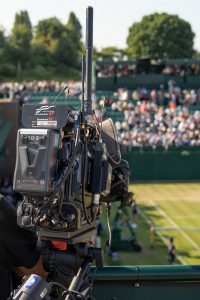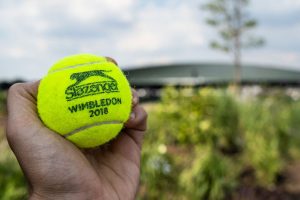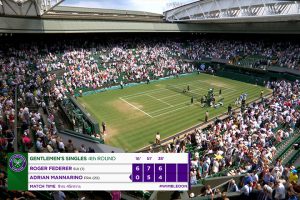Live from Wimbledon: Key suppliers help new host broadcaster take coverage to next level
 As it embarks on its first Wimbledon as host broadcaster, Wimbledon Broadcast Services (WBS) is working not only with its technical partner NEP but also a string of service providers that are helping it to achieve its ambitions.
As it embarks on its first Wimbledon as host broadcaster, Wimbledon Broadcast Services (WBS) is working not only with its technical partner NEP but also a string of service providers that are helping it to achieve its ambitions.
Among the suppliers are MOOV, who is responsible for branding the on-screen graphics, Aerial Camera Systems, the specialist camera provider, and Broadcast RF, the wireless camera systems company.
The client-supplier relationships differ depending on each company but can be either direct, between the All England Lawn Tennis Club (AELTC) and the service provider, or via NEP, as AELTC broadcast manager Bethan Evans explains.
“We can do the contracts directly when it works for us and then NEP has sub-contractors too where they are more embedded in their systems. There is a real mixture. With Broadcast RF, for example, that is a direct contract with AELTC. That gives us the control and the chance to get the best out of the RF model. And then with others, we recognise that NEP is best-placed to do the sub-contracting.
“The enthusiasm that some of the new companies bring is so great. They see some things that we’ve never seen.”
Wireless camera network

Thanks to Broadcast RF’s network, wireless cameras are able to roam around the entirety of the AELTC
Broadcast RF, part of the Euro Media Group, is providing the wireless camera network for WBS.
The RF receive infrastructure features 36 antennas spread over the site, allowing cameras to go pretty much anywhere. And during Wimbledon, they do exactly that.
In Centre Court, operators can wander from the back row of seats right the way down to grass level. Throughout the club grounds, wireless crews can be anywhere up to and including ‘The Queue’, the line of fans waiting outside AELTC in the hope of getting a ticket to see some tennis.
The RF set-up for Wimbledon 2018 is “broadly similar” to previous years, says technical project manager Nick Fuller, but of course, the client is different now with WBS calling the shots.
Where there is a big change is in the number of broadcasters using the RF network. In 2017, it was eight clients, including the host and the Wimbledon Channel. This year it is 10.
Another major change is that Centre Court coverage is now UHD and HDR.
“Because it is Hybrid Log Gamma (HLG), it doesn’t really worry us,” says Fuller.
“Unlike other flavours of HDR, there is no metadata required. We just have to make sure that we can pass the HLG though. In RF terms, the fundamental operation is the same, although clearly more bandwidth is required.”
“The grounds are immaculate so we’ve gone to great lengths to hide antennas in inconspicuous positions.”
The biggest challenge is ensuring that the Broadcast RF equipment “doesn’t stick out like a sore thumb,” he says.
“The grounds are immaculate so we’ve gone to great lengths to hide antennas in inconspicuous positions. We’ve even had rain covers made in Wimbledon green so that the kit blends in. We’ve done the same for the cameras too.”

The wireless monitor is usually operated by non-technical staff so it “just has to work”.
One interesting new addition for 2018 is the option to allow crews to have wireless monitors (pictured, left) as well as cameras.
“Some broadcasters want a roving monitor so that presenters can commentate on VT clips,” says Fuller.
“In previous years, we’ve had one transmit position on the roof of the Broadcast Centre for this but it hasn’t given site-wide coverage because of the height of the bigger courts [which get in the way of the signals]. For this year, we developed, in-house, a system that would allow us to put four transmit positions in place for site-wide coverage.”
Fuller describes it as a very “hands-off” system. “The monitor is usually operated by non-technical staff so it just has to work without any intervention. We use the same frequencies across all four transmitters so that it is always on.”
Specialist cameras
Aerial Camera Systems, also part of the Euro Media Group, is providing 36 remotely operated cameras across three distinct areas for WBS: the press room; beauty shots; and court-side.
On Centre Court, that consists of five Sony HDC-P43 UHD point-of-view cameras, including a baseline track and an umpire camera. There are also three Sony HDC-P1 cameras on Court No.1 and several more across various outside courts.
Each court-side camera is mounted on a remote SmartHead2 (some with arms) and is controlled from inside the relevant OB truck. Each truck has two operators who are responsible for all of the available remote ACS cameras. A programmable shot box allows for repeat moves and positions.
“The UHD is the big change for us this year as it required significant investment in a new generation of camera channels.”
For beauty shots, all rights holders have access to the live ACS camera feeds with shots called for via the host QC. One of the cameras, attached to the Clubhouse, is fitted with a Canon UJ90 box lens and SmartHead3 to capture skyline shots across London. As with the court-side cameras, operators control more than one camera and thanks to a rota system, a crew member is available to react to shot requests at all times during the day. Operators are based deep within the Broadcast Centre.
In each case, ACS provides the full camera system for WBS including the head, the lens, the camera and the base station. In some cases, it also supplies the vision engineers to operate them. In total, ACS has 30 staff working on the Championships during over the fortnight.
“The UHD is the big change for us this year as it required significant investment in a new generation of camera channels, the P43s,” says ACS sales director Matt Coyde.
“WBS has also added four new court camera positions, including a low reverse on Centre Court and reverse positions on Courts 2 and 3.”
ACS is also delivering the iconic ‘aerial’ hoist shots of the All England Club in UHD/HDR.

On-screen graphics
MOOV is the company responsible for branding the on-screen graphics for WBS.
For 2018, it has created a huge bouquet of bespoke graphics elements including stings, wipes, large scoreboard content and the entire match and presentation graphics pack.
And everything was created in advance, as MOOV director Nev Appleton explains.

Match Summary graphics were designed and created ahead of the tournament
“WBS wanted to ensure that the design and delivery of every graphic was cared for and thought about and, more importantly, on-brand. As a result, every permutation and template has been designed ahead of the championships and delivered with guidelines to all of WBS’ rights holders. Every single graphic has been considered in HD and UHD down to the pixel – I’m proud to say nothing has been made ad hoc or off-brand during the event.”
The Wimbledon logo has also been made more prominent this year, he adds.
“This was a real opportunity to use the Wimbledon brand as a driver for the graphics. More often than not, event and sponsors are secondary to the graphic, reduced in size and just put anywhere. We wanted the exact opposite with the logo and brand confidently owning every graphic. For the majority, the logo kicks off the the animation, and we then made sure every font used was of the right weight and colour depending on the importance of data. Finally, it also had to be clear on all platforms which I think we accomplished well.”
“What WBS has achieved in such a short space of time is remarkable.”
During the Championships, MOOV also has two teams of operators and coordinators on site at the AELTC, controlling graphics playout using their own tennis software to drive ChryonHego systems.
One of the teams serves BBC Sport for presentation and data graphics across BBC1 and BBC2, an arrangement that has been in place done for the last 15 years. The second team works directly for WBS on The Wimbledon Channel and also the World Feed.
“What WBS has achieved in such a short space of time is remarkable,” says Appleton.
“You can see that WBS have engaged with people and partners who know what they are doing not only technically, but they also have a great understanding of tennis and major events. They also had the vision and a desire to do it properly. That is what it boils down to.”

Read more about Wimbledon Broadcast Services and the host broadcast operation
